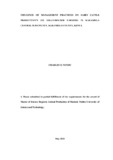| dc.description.abstract | Dairy production has always been the main stay of the Kenyan economy, however many counties Kakamega included have suffered perennial milk deficiencies and production fluctuations against a backdrop of an expected increase in human population in rural households. This necessitated the need to investigate the underlying factors that influence this situation and their individual effect on dairy cattle productivity, and to suggest ways on how to overcome them. The purpose of this study was to investigate the influence of management practices on dairy cattle productivity among smallholder farmers in Kakamega Central Sub County, Kenya. The study was guided by three objectives; (i) to determine the effect of nutritional management practices on dairy cattle productivity among smallholder farmers in Kakamega Central Sub County, Kenya (ii) to determine the effect of reproduction management practices on dairy cattle productivity among smallholder farmers in Kakamega Central Sub County, Kenya and (iii) to evaluate the contribution of housing environment management practices on dairy cattle productivity among smallholder farmers in Kakamega Central Sub County, Kenya. The study adopted aCorrelational survey research design, with a focus on smallholder dairy farmers in Kakamega Central Sub County, in Kakamega County, Kenya. The study target population were the 4000 dairy farmers in the research area, who owned between 1 and 5 dairy cows and either supplied milk to a local dairy cooperative or sold milk in the open air market. From this, a sample of 400 farmers were selected and used as respondents, through multistage random and purposive sampling techniques. Data collection involved the use of interview guide, observation checklist, focus group discussions and key informant interview. A Pilot study was carried out in Butsotso South ward, to assess the suitability of the research instruments. Their validity was tested using experts, while their reliability was tested by test-retest method, where all the instruments surpassed the set thresholds for reliability and validity. Data was analyzed using SPSS version 20. Descriptive statistics were analyzed in frequencies and percentages then presented in tables, histograms and pie charts. Inferential statistics were annalysed through Regression, correlation and simple t-test.Findings revealed thatproper nutritional management comprising of sufficient feeds, watering, mineral supplementation and frequent deworming and vaccination significantly influenced dairy productivity.[r=.725,p=.001,α=.05]Reproduction management practices (Breed selection, heat detection, heat stress management and pregnancy detection) had a strong positive association with their dairy cattle productivity.[r=.749,p=.02,α=.05]There was a moderate positive association between the selected smallholder farmers housing environmental management scores and their dairy cattle productivity scores [r=.512, p=.01 at α=.05]. The study also revealed that the government approach of demand driven extension services contributed to lowering farmers’ awareness of the best management practices to in cooperate in their farming activities. These research findings provide data that might be useful to the dairy farmers, Ministry of Agriculture in the County Government of Kakamega and the National Environmental Management Authority for future policy actions. | en_US |

